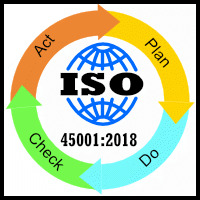|
|
ISO 45001:2018 IntroductionSend comments on this topic |
FREE QHSE Software Click <HERE> to Learn More |
||
QHSE Support >(Site Map) Health & Safety Guidance > ISO 45001:2018 >
ISO 45001:2018 Introduction
Foreword: Whilst there is much general guidance on ISO 45001 2018 within the pages of this qhse.support website, those organizations looking to gain accreditation will need to obtain a copy of the standard. The British Standards Institution (BSI) link to ISO 45001 2018 For a mandatory publication, it's reassuringly expensive...
ISO 45001 2018 supersedes BS OHSAS 18001 2007, which has been withdrawn.
"The goal of ISO 45001 is the reduction of occupational injuries and diseases"
ISO 45001:2018 is the world's first international standard for occupational health and safety. Aligning more closely with other International Standards for Quality (ISO 9001) and Environmental Management (ISO 14001), the standard uses the concept of the Plan, Do, Check, Act cycle (PDCA), along with risk-based thinking to provide a guidance framework document for organizations wishing to implement or develop their own OH&S systems.
The fundamental premise of the 45001:2018 OH&S standard is to offer guidance on maintaining a safe and healthy workplace for both the direct workforce and anyone impacted by its operations. Concurrently, it aims to foster ongoing enhancement of OH&S performance through continuous improvement efforts.
To varying degrees, most organizations will have OH&S management systems already in place. ISO 45001:2018 will provide a framework that caters for a holistic OH&S operation, where deficiencies will be routinely diagnosed; enabling the organization the opportunity to manage any previously unseen shortcomings.
ISO 45001:2018 compliance is not a legal requirement. However, following the framework of the document will assist in identifying an organization's legal obligations.
Simple PDCA cycle (also for interest see the health and safety PDCA INDG 275 guide).
For an organization to achieve compliance, it's essential to grasp the requirements outlined in the standard. Throughout ISO 45001:2015, specific verbal forms are employed to underscore its intent. These linguistic nuances help distinguish between requirements, recommendations, permissions, possibilities, and capabilities, aiding in a comprehensive understanding of the standard's objectives
ISO 45001 2018 uses the following four verbal forms:
a) “shall” indicates a requirement;
examples: is required to, it is required that, has to, it is necessary
b) “should” indicates a recommendation;
examples: it is recommended that, ought to
c) “may” indicates a permission;
examples: is permitted, is allowed, is permissible
d) “can” indicates a possibility or a capability.
examples: be able to, there is a possibility of, it is possible to
Footnote: The inspectors and incident investigators of any given country will continue to base their assessments of an organization's compliance with health and safety laws on a diverse array of verifiable evidence and surveillance observations. Accreditation to the ISO 45001:2018 standard, while significant, will not be the sole determining factor in their evaluations.
Help file v2.276.407 : QHSE Support - Website On Safe Lines
onsafelines.com QHSE Software 2025 : Webmaster: Brian G. Welch MSc(QHSE), NVQ4(OH&S), CMIOSH



